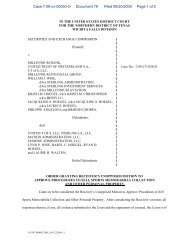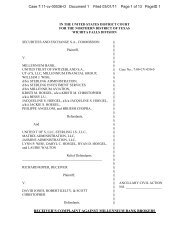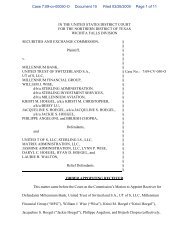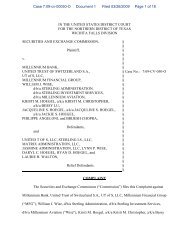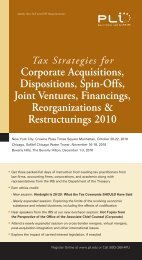View the full text of this document - Martindale.com
View the full text of this document - Martindale.com
View the full text of this document - Martindale.com
You also want an ePaper? Increase the reach of your titles
YUMPU automatically turns print PDFs into web optimized ePapers that Google loves.
est practices<br />
Surfacing Patentable<br />
Corporate Innovations<br />
ROBERT J. PUGH | THE PNC FINANCIAL SERVICES GROUP, INC.<br />
Robert J. Pugh is chief counsel, Technology and Intellectual Property, at The PNC Financial Services Group, Inc.<br />
in Pittsburgh. Robert recently co-chaired Counsel to Counsel forums on <strong>this</strong> subject. He can be reached at<br />
robert.pugh@pnc.<strong>com</strong>.<br />
implementation steps<br />
Most <strong>com</strong>panies recognize <strong>the</strong> value and<br />
situation<br />
importance <strong>of</strong> patenting corporate innovations.<br />
For some industries, such as <strong>the</strong> financial services<br />
industry, <strong>the</strong>se protectable innovations include processes, generally<br />
implemented by <strong>com</strong>puters, involved in operating a business or that<br />
define a service <strong>of</strong>fering (sometimes referred to as “business methods”).<br />
However, many <strong>com</strong>panies in <strong>the</strong>se same industries do not have a long<br />
history <strong>of</strong> or established culture surrounding patenting such innovations.<br />
in-house counsel<br />
challenge<br />
Corporate counsel must establish a simple way<br />
to identify new technology-based systems<br />
and processes that may be candidates for patent<br />
protection. This can be especially difficult in industries where <strong>the</strong>re’s<br />
little history <strong>of</strong> seeking such patents.<br />
approach<br />
adopted<br />
Begin with an internal education program.<br />
Develop and broadly distribute informational<br />
materials explaining <strong>the</strong> types <strong>of</strong> methods<br />
and systems that are patentable and why patent protection is<br />
important. Include any examples <strong>of</strong> innovations your <strong>com</strong>pany has<br />
already sought to patent. Target for more focused <strong>com</strong>munications<br />
those areas within <strong>the</strong> <strong>com</strong>pany that are most likely to develop<br />
patentable innovations, such as departments responsible for product or<br />
application development. Establish points <strong>of</strong> contact for those seeking<br />
more information.<br />
Try to leverage existing databases and systems within <strong>the</strong> <strong>com</strong>pany to<br />
help identify patentable innovations. For example, check with your<br />
IT department to see if your <strong>com</strong>pany currently employs one or more<br />
databases to track technology-based projects. PNC, for example,<br />
maintains a “Technology Initiatives” database. When new technologybased<br />
initiatives are launched, <strong>the</strong>y are entered into and tracked within<br />
<strong>this</strong> database. The project managers enter information concerning <strong>the</strong><br />
initiatives into <strong>the</strong> database, including <strong>the</strong>ir name, department, contact<br />
information and detailed descriptions <strong>of</strong> <strong>the</strong> initiative.<br />
• Spearhead a campaign that explains what is patentable and why<br />
patent protection is important.<br />
• If possible, provide examples <strong>of</strong> systems and methods your<br />
<strong>com</strong>pany has already sought to patent.<br />
• Provide extra focus to those areas <strong>of</strong> <strong>the</strong> <strong>com</strong>pany most likely to<br />
develop patentable methods or systems, such as <strong>the</strong> product or<br />
application development departments.<br />
• Check with IT to see whe<strong>the</strong>r a database already exists for<br />
tracking new technology-based initiatives.<br />
• Leverage that database to obtain leads on potentially patentable<br />
technology-based systems and methods.<br />
To leverage <strong>the</strong> database, <strong>the</strong> Legal department added a simple yet<br />
effective step—embedding a short series <strong>of</strong> “yes” or ”no” questions<br />
concerning <strong>the</strong> initiative into <strong>the</strong> database and requiring each project<br />
manager to answer <strong>the</strong>m. Examples <strong>of</strong> <strong>the</strong>se questions include:<br />
“Does your initiative involve a system or process that is not currently<br />
available from a vendor?” and “Are <strong>com</strong>petitors using similar systems<br />
or processes?” The questions take less than a minute to answer,<br />
and, if certain responses are given, an electronic <strong>com</strong>munication is<br />
automatically forwarded to Legal identifying <strong>the</strong> initiative as one<br />
meriting fur<strong>the</strong>r investigation. Often, <strong>the</strong>se types <strong>of</strong> project tracking<br />
databases already include codes to identify <strong>the</strong> type <strong>of</strong> initiative. You<br />
can set up <strong>the</strong> questions so that when certain codes are selected (such<br />
as routine building maintenance) <strong>the</strong> questions are not presented,<br />
since <strong>the</strong>se types <strong>of</strong> initiatives are unlikely to involve patentable<br />
innovation.<br />
measuring<br />
success<br />
The electronic tool described here has<br />
helped bridge <strong>the</strong> gap between <strong>the</strong> PNC<br />
Legal department and those who develop<br />
new business methods and systems, accumulating numerous<br />
leads on potentially patentable developments. As a result, PNC<br />
is building a solid portfolio <strong>of</strong> pending patent applications.<br />
12 www.martindale.<strong>com</strong>



